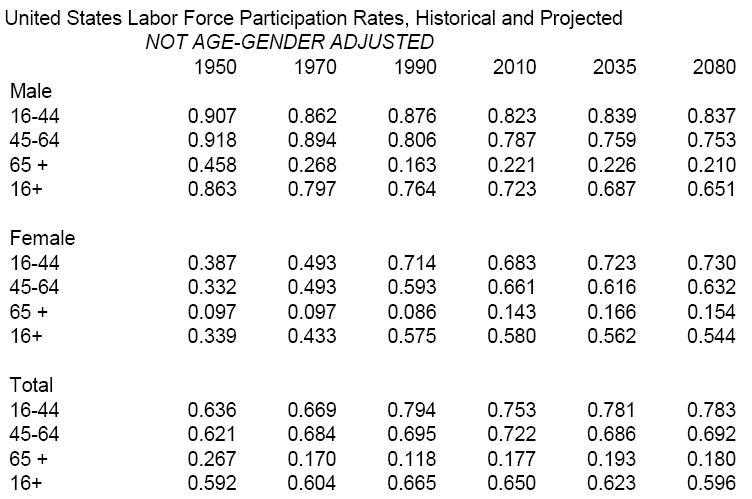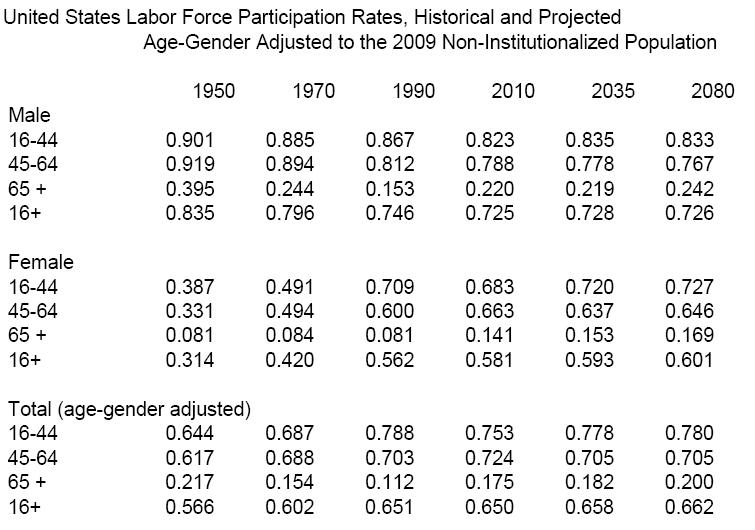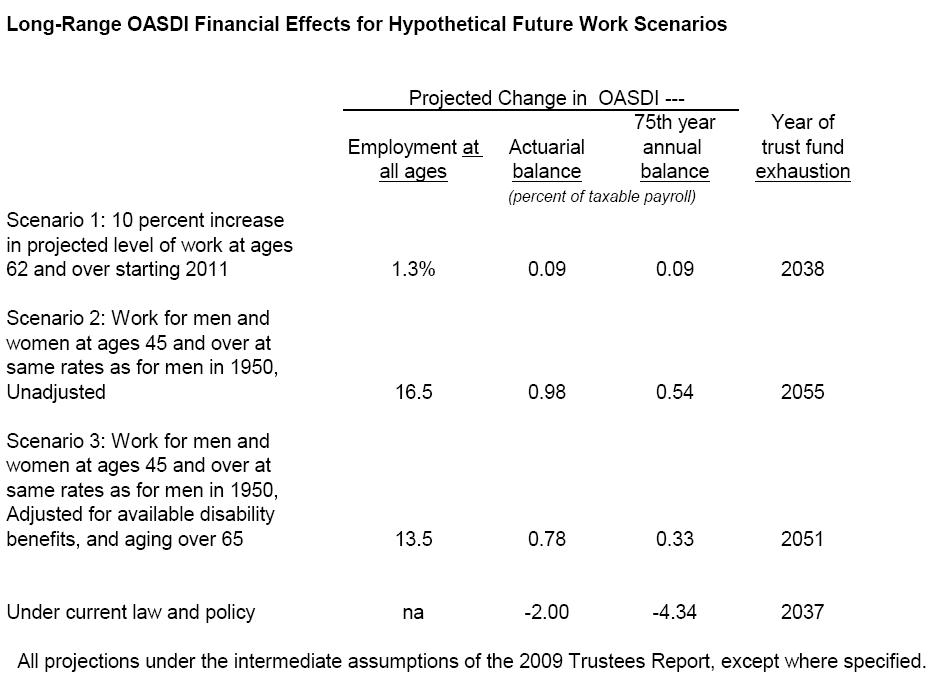Choosing to Work During Retirement and the Impact on Social Security
Testimony to United States Senate Committee on Finance
By Stephen C. Goss, Chief Actuary
Social Security Administration
July 15, 2010
Mr. Chairman, Ranking Member, and members of the committee, thank you for the opportunity to discuss this important topic today. The aging of our population in the future will challenge the financing of Social Security, Medicare, and all private retirement and health systems. Finding ways to encourage Americans to work longer and to be more productive can potentially contribute to meeting the financial challenges that lie ahead.
The Nature of the Aging Challenge
Death rates have declined gradually over the last century and we are living longer. However, there will be an enormous change in the age distribution of our population over the next 25 years. For the Social Security program, we have had about 3.3 contributing workers for each beneficiary from 1975 to 2008. By 2035, we project that we will have only about 2 contributing workers for each beneficiary. This dramatic change will occur principally because the large baby boom generation will pass from working age to retirement age over this time, and will be replaced by relatively smaller generations due to the permanent decline in birth rates after 1965. It is this shift in birth rate that will cause, inevitably, a large and permanent change in the age distribution of our population that will challenge all aspects of our economy.
Implications for Employment and Economic Output
As we have been living longer, we have also in general been living healthier with a greater capacity to work. However, over about the last 40 years, as the baby boom generation moved into working ages and more recently the prime working ages, with steadily rising employment for women, we have had an ample supply of workers to provide for our needs and to facilitate an increasing standard of living. In fact, employers have offered older generations opportunities to retire early as the boomers and more women moved into the labor force.
Since 1950, employment has been rising at least as fast as total population. This has meant that per capita GDP, a good measure of our standard of living, has risen at least as fast as per worker output (i.e., labor productivity). However, between now and 2035, slower growth in employment than in total population will reduce our general standard of living (as measured by per capita GDP) in relation to the average worker’s output. As a result, providing benefits for the faster growing aged population will place a larger burden on the average worker.
| Annual Change in GDP Per Capita and Per Hour of Work | ||
| GDP | GDP per | |
| PerCapita | Hour of Work | |
| 1950-67 | 3.2 |
2.7 |
| 1967-2008 | 1.7 |
1.7 |
| 2008-35 | 1.5 |
1.7 |
| 2035-80 | 1.7 |
1.7 |
Between now and 2035, per capita GDP is projected to grow by about 5 percent less than average worker output. This shift to a relatively lower general standard of living by 2035 is projected to be “locked in”, with growth in per capita GDP and average output per worker after 2035 being the same.
Finding ways for US workers to be more productive and to work longer, particularly between now and 2035, can help soften the economic effects of population aging. The 2009 Trustees Reports project that the productivity of our workforce will continue at the historic rate of the past 40 years on the assumption that improvements in technology will offset the expected slowdown in the rate of increase in educational attainment. The reports also assume that workers will tend to work longer as life expectancy and health improve. Offsetting this assumption is the expectation that disability prevalence will continue to climb somewhat in the future. Overall, the Trustees project that labor force participation will not change substantially from recent levels under current policy.
Potential for Increased Work
In a highly competitive world labor market, where barriers of time and distance have eroded and outsourcing or work across borders has increased, the mere availability of a supply of labor in the US is not enough. Having the skills and abilities to compete will be critical. Future policies to enhance the skills of US workers can contribute to the demand for their services in employment.
Since 1950, labor force participation has changed dramatically in the United States. The chart below illustrates on both unadjusted and age-gender-adjusted bases the changes that have occurred and are expected to occur based on the intermediate assumptions of the 2009 Trustees Reports. Because the population has tended to get older within all age groups starting at age 45, and participation rates tend to be lower at higher ages, the unadjusted participation rates do not illustrate the true extent to which participation has increased over time on an age-specific basis for the population as a whole (total of male and female). On an age-gender-adjusted basis, the labor force participation rate for all ages 16 and over has risen from 56.6 percent in 1950, to 65 percent for 2010, with a further small increase projected to 66.2 percent by 2080. On the gross, unadjusted basis, the total rate was at 59.2 percent for 1950, rising to 65 percent for 2010, and then dropping to 59.6 percent by 2080 as the aging of the population puts increasing weight on the very high ages where few remain in the labor force.


For the purpose of illustration, we have developed three hypothetical scenarios for increased labor force participation in the future beyond what the Trustees project under current law and policy. It should be noted that in each of these scenarios it is assumed that the additional supply of labor being assumed would be met with increased demand, so that total employment would increase to the same extent as for the labor force.
Scenario 1: Increase Work at Age 62 and Older by 10 Percent
As indicated in the table above, labor force participation has declined generally for men and has risen for women since 1950 and 1970. Under the Trustees intermediate assumptions, participation rates are projected to rise in the future at age 65 and older, on an age adjusted basis, to levels closer to those experienced back in 1970 for males and to double the rates from 1970 for females.
Under this scenario, we consider the effect of an additional 10-percent rise in labor force participation at ages 62 and older becoming effective by 2011. We estimate that an increase at this level would add about 1.3 percent to the taxable earnings for the Social Security program. The additional revenue would be partially offset by additional benefits earned by some workers gaining insured status, and others having increased average career earnings levels. An increase on this order would improve the long-range OASDI actuarial deficit, reducing it from the 2.00 percent of taxable payroll estimated under current law by about 0.09 percent, to a deficit of 1.91 percent of payroll. The trust fund exhaustion date would be extended by one year, from 2037 to 2038. The annual deficit in the 75th projection year would also be reduced by 0.09 percent of taxable payroll.
Scenario 2: Increase Labor Force Participation to the 1950 Male Rates, Unadjusted
Under this hypothetical scenario, labor force participation at ages 45 and older would rise by 2011 for both men and women to the rates experienced in 1950 by men alone. This would clearly be a dramatic increase in overall employment above current and projected levels. The assumed increases in labor force participation do not reflect the availability of disability benefits under the Social Security program, which started in 1957, or the increasing average age of the group age 65 and older.
Overall, this scenario would imply an increase in Social Security taxable earnings of about 16.5 percent over projected levels. The additional revenue would be partially offset by additional benefits earned by some workers gaining insured status, and others having increased average career-earnings levels. An increase on this order would improve the long-range OASDI actuarial deficit, reducing it from the 2.00 percent of taxable payroll estimated under current law by about 0.98 percent, to a deficit of 1.02 percent of payroll. The trust fund exhaustion date would be extended by 18 years, from 2037 to 2055. The annual deficit in the 75th projection year would be reduced by 0.54 percent of taxable payroll.
Scenario 3: Increase Labor Force Participation to the 1950 Male Rates, Adjusted
Under this hypothetical scenario, labor force participation at ages 45 and older would rise by 2011 for both men and women to the rates experienced in 1950 by men alone. However, the assumed increases in labor force participation here reflect the availability of disability benefits under the Social Security program, which started in 1957, and the increasing average age of the group age 65 and older. For individuals projected to be receiving disabled worker benefits in the future at ages 45 to 66, the assumed increase in labor force participation is assumed to be half as large as the general increase implied by a return to 1950 male rates. In addition, labor force participation over age 65 is here assumed to be at 1950 rates on an age-specific basis so that rates for the entire age group 65 and older would tend to decline somewhat as the average age for the group increases.
Overall, this scenario would imply an increase in Social Security taxable earnings of about 13.5 percent over projected levels. The additional revenue would be partially offset by additional benefits earned by some workers gaining insured status, and others having increased average career-earnings levels. An increase on this order would improve the long-range OASDI actuarial deficit, reducing it from the 2.00 percent of taxable payroll estimated under current law by about 0.79 percent, to a deficit of 1.21 percent of payroll. The trust fund exhaustion date would be extended by 14 years, from 2037 to 2051. The annual deficit in the 75th projection year would be reduced by 0.33 percent of taxable payroll.
